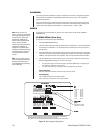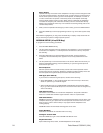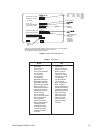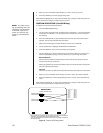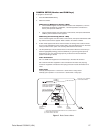
Pelco Manual C581M-B (1/04) 23
Spot Monitor Display
If you want the spot monitor to switch to cameras that have alarms or activity
detection, select BLANK, SEQUENCE, or TRACK MAIN, then under RESPONDS TO
select ALARMS, ACTIVITY, or ALARMS/ACTIVITY. If you are using the spot monitor
for normal video and you do not want alarms or activity detection to override what you
are observing, select NONE.
BLANK - Allows you to view an individual camera, but you cannot run a sequence. An
alarm or activity detection will override the camera you are viewing. When the alarm or
activity detection goes away, the screen will return to the camera you were viewing.
SEQUENCE - Allows you to view an individual camera or run a sequence. An alarm or
activity detection will override what you are observing. When the alarm or activity
detection goes away, the screen will return to the camera or sequence you were
viewing.
TRACK MAIN - The spot monitor will follow the camera switching that occurs on the
main monitor. This feature is used only when a KBD4002 keyboard is connected to the
multiplexer for controlling moveable cameras. This mode provides an easy method of
simplifying P/T/Z control in single-monitor applications. The operator does not have to
switch to SPOT to gain P/T/Z control and there is no separate control of the spot
monitor when in this mode. However, to do presets and patterns, switch to SPOT.
Aux Monitor Display (Duplex Multiplexer Only)
Select ALARMS, ACTIVITY, or ALARMS OR ACTIVITY if you want the auxiliary
monitor to show cameras with alarms or activity detection. If you are using the
auxiliary monitor to sequence all cameras and you do not want alarms or activity
detection to override the sequence, select NONE.
BLANK - This means the screen will remain blank unless there is an alarm or activity
detection.
SEQUENCE - This means the monitor will sequence all cameras unless there is an
alarm or activity detection.
CAM 1 through CAM 16 - This means the monitor will display the selected camera
unless there is an alarm or activity detection.
Camera Types
The COLOR & B/W setting allows the multiplexer to adapt to the combination of both
color and monochrome video signals. The switching speed of the multiplexer is not as
fast when it has to change formats between monochrome and color cameras. For
duplex monochrome models, you will not receive color from a color camera except
on the SPOT or AUX monitor displays. For simplex monochrome models, you will
not receive color from a color camera except in RECORD mode.
The RESERVED setting can improve performance when using cameras with
non-standard sync or poor video quality.
Unit ID
This is the address of the multiplexer. If your system has more than one multiplexer,
each multiplexer must have its own address. This must be set at the multiplexer, not at
the keyboard.
Comm.Type
In the polled communication mode (switch 4 OFF), one multiplexer (any one) must
be the master. Only one multiplexer can be the master. All other multiplexers must be
slaves. The master multiplexer communicates with the slave multiplexers.
In the non-polled communication mode (switch 4 ON), all multiplexers must be
slaves.
The default is SLAVE for duplex multiplexers and MASTER (KBD T/D) for simplex
multiplexers.
CAUTION:
When
programming the
MX4000
Multiplexer from the
KBD4002 Keyboard,
DO
NOT ATTEMPT TO
CHANGE THE UNIT ID.
Changing the unit ID from
the keyboard will interrupt
the keyboard
communications to the
multiplexer, resulting in
erratic multiplexer operation.
Refer to the
Troubleshooting
section, in this manual to
correct the situation.








